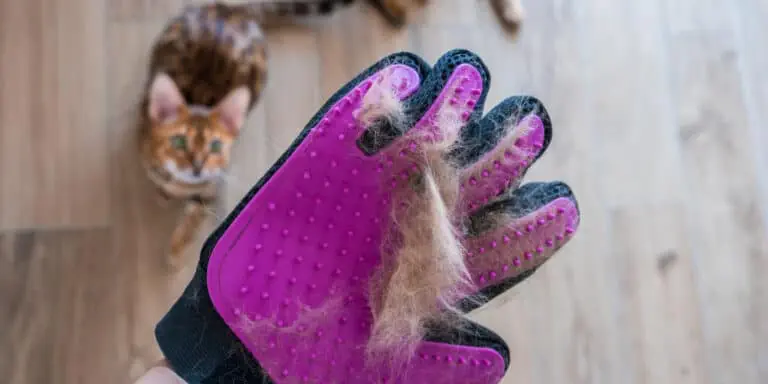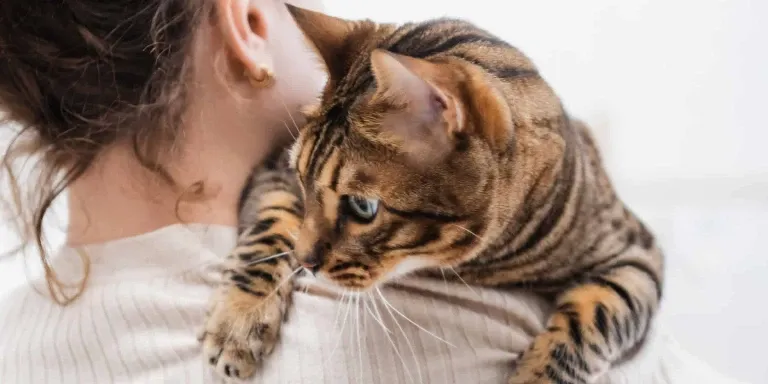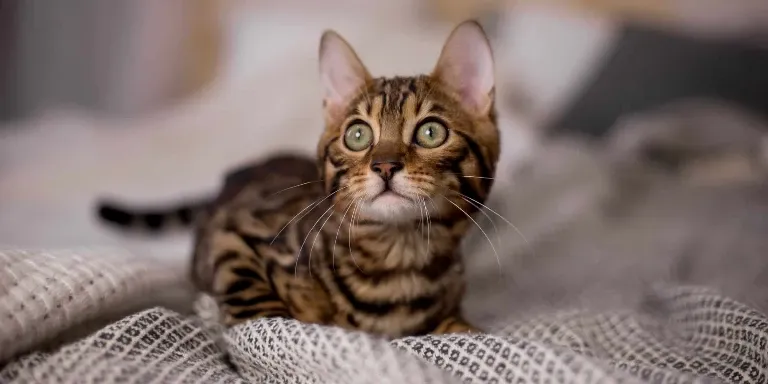The Best Fluffy Pancakes recipe you will fall in love with. Full of tips and tricks to help you make the best pancakes.

Are you tired of the same old standard issue cats that seem to blend in with the crowd? Do you want a feline companion that stands out with unique physical characteristics, a fascinating history, and a lively personality? Look no further than the Bengal cat.
Bengal cats are different than other standard issue cats in a few ways. They have a distinctive coat pattern, which is similar to that of a wild leopard or jaguar. Bengal cats are also known for their high energy levels and love for water, making them more active and playful than other cats. Additionally, they are known for their intelligence and ability to learn tricks and commands.
Bengal cats are a breed like no other, with distinctive coat patterns that mimic the markings of wild cats, a playful and adventurous spirit, and a history that traces back to the 1960s when a domestic cat was bred with an Asian leopard cat.
In this article, we’ll explore the ways in which Bengal cats differ from other breeds in terms of physical features, personality traits, behavioral tendencies, health and care needs, and interactions with other animals.
So buckle up and get ready to learn about this captivating and unconventional feline companion.
Physical Characteristics
You’ll notice right away that Bengal cats have a distinctive coat with spots, stripes, or marbling patterns, making them stand out from your average feline. These patterns come in a variety of color variations, ranging from brown and black to silver and snow. Their fur is short, soft, and dense, with a glossy sheen that adds to their elegant appearance.
Bengal cats have a muscular and athletic build, with a long and lean body that is supported by strong legs. Their head is wedge-shaped, with small ears that are set far apart and tilted forward. Their eyes are large and expressive, with colors that range from green to gold.
All of these physical characteristics come together to create a unique and captivating appearance that sets the Bengal cat apart from other standard issue cats.
Origins and History
Did you know that the origins and history of Bengal cats are just as fascinating as their unique personalities? These striking felines are the result of a crossbreeding between an Asian leopard cat and a domestic shorthair. This evolutionary lineage dates back to the 1960s, when a breeder named Jean Mill sought to create a domestic cat with the wild appearance of a leopard.
Since then, Bengal cats have gained cultural significance as beloved pets and show cats. Here are five interesting facts about their origins and history:
- Bengal cats were first recognized as a breed in 1983 by The International Cat Association (TICA).
- The breed’s popularity skyrocketed in the 1990s, and today, Bengal cats are one of the most sought-after cat breeds in the world.
Due to their wild ancestry, Bengal cats are often described as ‘high-energy’ and ‘active’ pets. Some Bengal cats have a ‘glitter’ gene that gives their fur a sparkly appearance in the sunlight. The breed’s name comes from the scientific name of the Asian leopard cat, which is Prionailurus bengalensis.
Bengal cats may have a wild appearance, but they make loving and loyal pets. Their unique history and cultural significance only add to their appeal as a beloved companion animal.
Personality Traits
It’s fascinating to observe how the personality traits of Bengal cats are indicative of their wild ancestry.
These felines are known for their playfulness and energy, often seen chasing toys and running around the house. They’re highly active and require plenty of stimulation to keep them entertained.
However, they’re also known for their aloofness, often preferring to observe from a distance rather than engage in physical affection.
Despite their independence, Bengal cats are also capable of being affectionate towards their owners. They’re highly intelligent and can form strong bonds with their humans, often following them around the house or curling up next to them for a nap.
However, they do require plenty of space and freedom to express their wild nature.
Overall, Bengal cats are a unique breed with a mix of playful and aloof personality traits, making them an ideal choice for those who desire a balance of affection and independence in their feline companion.
Behavioral Differences
When observing behavior, notice how Bengal cats may differ in their movements and reactions compared to what you’re used to seeing in typical domesticated cats.
One noticeable difference is their high energy level, which makes them more active and playful. They’re known to jump higher, run faster, and climb higher than other cats. They also have a strong hunting instinct, which means they may be more prone to chasing and catching prey, such as birds and mice.
To curb these hunting instincts, training techniques and socialization methods may need to be employed. For example, providing ample toys and playtime can help channel their energy and satisfy their hunting instincts. Additionally, socializing them with other cats at a young age can help them learn appropriate behavior and decrease their aggression towards other animals.
It’s important to note that these cats are highly intelligent and require mental stimulation, so providing challenging toys and puzzles can also help keep them entertained and prevent destructive behavior.
Health and Care
Taking care of Bengal cats requires more effort than taking care of other standard issue cats due to their unique health needs and grooming requirements. These felines have a higher energy level and require more protein in their diets compared to other cats. Their nutritional needs are different, and it’s essential to provide them with a balanced diet that includes high-quality proteins, fats, and carbohydrates.
Feeding your Bengal cat a balanced diet will help them maintain good health and prevent obesity and other health problems. In addition to their unique nutritional needs, Bengal cats have specific grooming requirements. They have short, dense fur that requires regular brushing to prevent matting and shedding. You also need to trim their nails regularly to prevent overgrowth, which can lead to painful paw injuries.
Bathing your Bengal cat should be done occasionally, as their coats don’t get oily or dirty quickly. Overall, taking care of a Bengal cat requires dedication and attention to detail, but the rewards are worth it as they make excellent companions and family pets.
Interactions with Other Animals
When it comes to interactions with other animals, Bengal cats are known for their sociability and playfulness. They tend to get along well with dogs, making them a great addition to multi-pet households.
However, the same cannot be said for all cats, as Bengals can have a dominant personality and may not always get along with other felines. It’s important to keep in mind their prey drive as well, especially if they’re allowed outdoors, as they may chase after birds or small animals.
Outdoor safety measures should be taken to ensure their safety and the safety of other animals in the area.
Compatibility with Dogs
Despite their wild appearance, Bengal cats are known for their friendly and sociable nature, making them a great companion for dogs. If you have a dog and are considering getting a Bengal cat, here are three things to keep in mind:
- Start with proper introduction – When introducing a Bengal cat to a dog, it’s important to do it gradually and in a controlled environment. Allow them to sniff each other from a distance and gradually decrease the distance over time. This will help them get used to each other’s presence and reduce the chances of any aggressive behavior.
- Use positive reinforcement training – Training techniques that involve positive reinforcement work best for both cats and dogs. Reward your pets with treats, toys, and praise when they behave well around each other. This will encourage good behavior and improve their relationship over time.
- Socialize your pets – Socialization methods are important for both cats and dogs to learn how to interact with each other and other animals. Expose them to different situations, people, and animals from an early age. This will help your pets become confident and well-adjusted, making it easier for them to get along with each other.
Bengal cats and dogs can make great companions when introduced to each other properly. By following these tips and using positive reinforcement training, you can help your pets develop a strong and loving relationship.
Interaction with Other Cats
It’s important to note that Bengal cats tend to have a more assertive and dominant personality compared to their feline counterparts, so introducing them to other cats requires careful supervision and gradual acclimation.
When introducing Bengal cats to other felines, it’s best to start with a gradual introduction. Allow the cats to smell each other’s scents through a closed door and gradually allow supervised interactions. Keep in mind that Bengal cats are known to be territorial, so managing their behavior is crucial to prevent conflicts with other cats.
Managing territorial behavior is key to successfully integrating Bengal cats into a multi-cat household. Providing separate feeding stations and litter boxes for each cat can help minimize competition and tension. It’s also important to provide plenty of vertical space and hiding spots for the cats to retreat to if they feel threatened or overwhelmed.
With patience, supervision, and proper management, Bengal cats can live harmoniously with other feline companions.
Prey Drive and Outdoor Safety
Now that you understand how Bengal cats interact with other cats, let’s talk about their prey drive and how to ensure their safety outdoors.
Bengal cats have a strong instinct to hunt, which means they may be more prone to chasing and attacking small animals like birds and rodents. This is why it’s important to properly train your Bengal cat and modify their behavior through positive reinforcement techniques.
Outdoor training combined with indoor entertainment can help satisfy your cat’s natural desire to hunt while also keeping them safe. To start, it’s important to provide your Bengal cat with plenty of toys and activities to keep them stimulated while indoors. This will help prevent boredom and reduce their urge to hunt.
Additionally, training techniques such as clicker training and positive reinforcement can help modify their behavior and reinforce good habits. When it comes to outdoor safety, it’s important to supervise your Bengal cat at all times and ensure they are on a leash or in a secure, enclosed area.
By taking these precautions and implementing these behavioral modifications, you can help ensure your Bengal cat stays safe and happy both indoors and outdoors.
Cost and Availability
When looking to add a Bengal cat to your home, it’s important to consider the cost and availability of these unique felines.
Pricing and adoption fees can vary depending on the breeder or rescue organization, so it’s crucial to do your research and find a reputable source.
You may also want to explore rescue and adoption options, which can provide a loving home to cats in need while often being more affordable than purchasing from a breeder.
Pricing and Adoption Fees
The adoption fees for Bengal cats are typically higher than those for other breeds due to their unique characteristics and popularity among cat lovers.
While the average adoption fee for a standard cat is around $50 to $150, the adoption fee for a Bengal cat can range from $500 to $2,000 depending on the breeder and the cat’s lineage.
However, it’s important to note that adoption fees cover much more than just the cost of the cat itself. Adoption fees often include spaying/neutering, vaccinations, and microchipping, all of which can add up to a significant expense.
If you’re unable to afford the high adoption fees for a Bengal cat, there are other options available such as rescuing a cat from a local shelter or purchasing a standard breed cat.
While purchasing a cat from a breeder can also be expensive, it’s important to consider the long-term expenses of owning a cat such as food, litter, and veterinary care.
Ultimately, the decision to adopt or purchase a Bengal cat should be based on your ability to provide a loving and stable home for the cat, rather than just the cost of the adoption fee.
Finding a Reputable Breeder
Locating a trustworthy breeder can be a challenging task, but it’s vital to ensure that your future Bengal cat is healthy and well-cared for.
One of the best ways to find a reputable breeder is through referrals from other Bengal cat owners or breed clubs. You can also search online for breeders in your area and check their reviews and ratings.
Once you have a list of potential breeders, it’s important to do your due diligence and interview them to make sure they meet your standards. Ask about their breeding practices, health screenings, and socialization methods for their kittens. A good breeder will be transparent and happy to answer any questions you have.
When interviewing a breeder, pay attention to the environment of their cattery. Is it clean and well-maintained? Are the cats and kittens healthy and happy? Ask to see the kittens’ parents and observe their temperament.
A reputable breeder will also provide you with a contract that outlines their health guarantee and any responsibilities you have as a new owner.
Remember that a Bengal cat is a long-term commitment, and finding the right breeder is the first step in ensuring a healthy and happy life with your feline companion.
Rescue and Adoption Options
Adopting a rescue feline can be a rewarding experience for both you and the cat. There are several options available for rescuing and adopting a Bengal cat.
One option is to look for breed specific rescues, such as the Bengal Rescue Network, which specializes in rescuing and rehoming Bengal cats. These rescues have a better understanding of the breed’s specific needs and can match you with a Bengal that fits your lifestyle.
Another option is to participate in fostering programs, which allow you to temporarily care for a rescue cat until a permanent home is found. Fostering can provide a safe and comfortable environment for the cat while they wait for their forever home. Additionally, fostering can help you determine if a Bengal cat is the right fit for your household and lifestyle.
Overall, rescuing or fostering a Bengal cat can provide a loving companion while also giving a second chance to a furry friend in need.
What Makes Bengal Cats Different From Other Cats That Makes Them Difficult To Keep?
Bengal cats care challenges stem from their high energy levels and need for mental stimulation. Unlike other cats, Bengals require more interactive play and attention to prevent boredom and destructive behaviors. Their wild ancestry also contributes to their strong hunting instincts, making them more challenging to keep in a typical household setting.
Conclusion
Now that you’ve learned about the unique physical characteristics, fascinating origins, and history, distinct personality traits, and behavioral differences of Bengal cats, it’s important to consider their health and care needs. These cats require regular veterinary check-ups, a balanced diet, and plenty of exercise and mental stimulation to thrive.
Additionally, it’s important to note that Bengal cats may not always get along with other animals, so careful introductions and supervision are necessary.
When it comes to cost and availability, Bengal cats can be more expensive than standard issue cats due to their rarity and high demand. However, with proper research and preparation, owning a Bengal cat can be a rewarding experience.
As with any pet, it’s crucial to provide a loving and safe home for your Bengal cat and to always consider their unique needs and behaviors.
In conclusion, Bengal cats are like rare gems – they stand out and require special attention and care, but with the right care, they can shine bright and bring immense joy to their owners. Their distinct physical characteristics, personality traits, and behavioral differences make them a fascinating addition to any household.
If you’re considering adding a Bengal cat to your family, be sure to do your research and provide them with the love and care they deserve.








